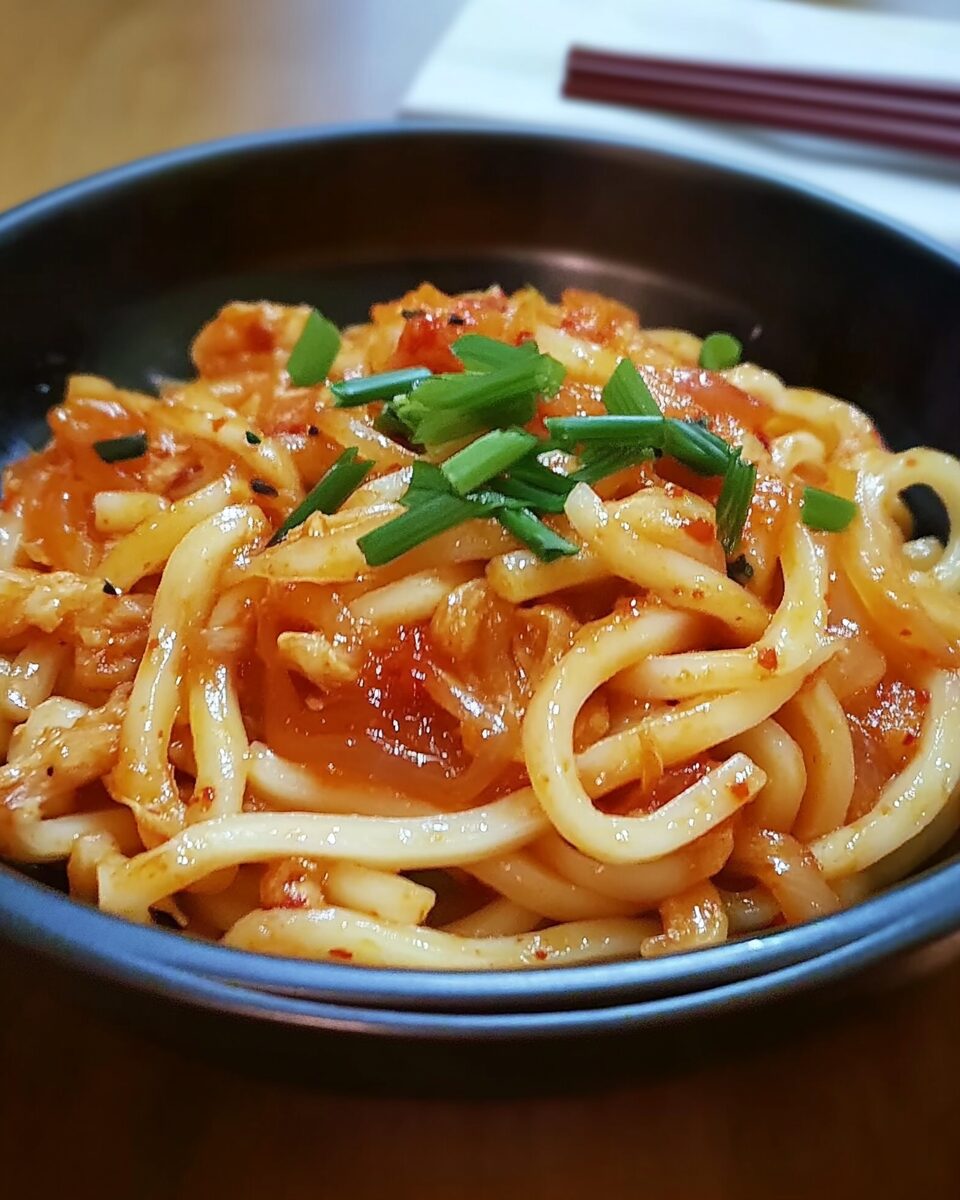Kimchi Udon Noodle Stir-Fry is a delightful fusion dish that combines the spicy, tangy flavors of kimchi with the chewy texture of udon noodles. This quick and easy stir-fry brings together the rich tastes of Korean cuisine in a comforting noodle bowl, making it a perfect choice for a satisfying dinner.
Full Recipe:
Ingredients
- 1 cup kimchi, roughly chopped
- 2 packets fresh udon noodles or about 6–7 ounces dry udon noodles
- 2 strips bacon, roughly chopped (optional – omit for vegetarian)
- 1 clove garlic, minced
- 1 tablespoon sriracha sauce
- 1 1/2 tablespoons honey
- 1 tablespoon soy sauce
- 1/2 tablespoon rice vinegar
- 1 teaspoon toasted sesame oil
- 4 stalks green onions, sliced on the bias
- 2 eggs (optional)
- Shredded nori (optional)
Directions
- Prepare the Udon Noodles: If using fresh udon noodles, gently separate them. For dry udon noodles, cook according to package instructions until al dente, then drain and set aside.
- Cook the Bacon (Optional): In a large skillet or wok over medium heat, cook the chopped bacon until crispy. Remove the bacon and set aside, leaving the rendered fat in the pan.
- Sauté Garlic and Kimchi: In the same skillet with the bacon fat (or with a tablespoon of oil for a vegetarian version), sauté the minced garlic until fragrant, about 30 seconds. Add the chopped kimchi and cook for 2–3 minutes until heated through.
- Combine Sauce Ingredients: In a small bowl, mix together sriracha sauce, honey, soy sauce, rice vinegar, and toasted sesame oil.
- Stir-Fry Noodles: Add the prepared udon noodles to the skillet with the kimchi mixture. Pour the sauce over the noodles and toss to combine, ensuring the noodles are evenly coated. Cook for an additional 2–3 minutes until everything is heated through.
- Add Bacon and Green Onions: Return the cooked bacon to the skillet and add half of the sliced green onions. Toss to combine.
- Serve: Divide the stir-fry into serving bowls. Top each serving with a fried or poached egg if desired, the remaining green onions, and shredded nori. Serve immediately.
Nutritional Facts (per serving)
- Calories: Approximately 400
- Total Fat: 15g
- Saturated Fat: 4g
- Cholesterol: 110mg
- Sodium: 1200mg
- Total Carbohydrates: 55g
- Dietary Fiber: 3g
- Sugars: 8g
- Protein: 12g
Origins and Influence of Kimchi and Udon
Kimchi is a staple in Korean cuisine, known for its pungent, spicy, and sour taste. Made primarily from fermented vegetables, typically napa cabbage and radishes, kimchi is often seasoned with chili peppers, garlic, ginger, and other spices. It’s widely enjoyed as a side dish and is integral to Korean meals. The fermentation process gives kimchi its unique sourness, which intensifies as it ages. The depth of flavor in kimchi makes it a versatile ingredient that can be used in various dishes, from stews to stir-fries.
On the other hand, udon noodles are thick, chewy wheat noodles that hail from Japan. They are a common feature in Japanese cuisine, often served in hot soups or stir-fried dishes. Udon’s soft and satisfying texture complements both delicate broths and rich stir-fries. The noodles themselves have a neutral taste, which allows them to soak up sauces and flavors, making them an ideal companion to the bold flavors of kimchi.
When these two elements come together in a stir-fry, the result is a savory and flavorful dish that combines the best of both worlds. The heat and tang of the kimchi pair perfectly with the tender, absorbent udon noodles, creating a dish that is both comforting and exhilarating.
Key Components of the Stir-Fry
The kimchi udon noodle stir-fry is an adaptable dish that allows for plenty of customization, depending on your preferences. The key components include the udon noodles, kimchi, vegetables, and a savory sauce. The udon noodles serve as the foundation, providing a chewy, satisfying base. Kimchi brings the heat and sourness, infusing the dish with deep flavors. Vegetables, such as onions, bell peppers, and carrots, add texture and freshness, balancing out the intensity of the kimchi. Finally, the sauce is what ties everything together, adding richness and umami to the dish.
Cooking Technique: Stir-Frying
The stir-frying technique used in this recipe is key to achieving the right texture and flavor profile. Stir-frying is a quick cooking method that involves cooking ingredients in a small amount of hot oil in a wok or a large skillet. This method ensures that the ingredients are cooked evenly while retaining their texture and flavor. Stir-frying also helps to infuse the kimchi and other seasonings into the noodles, making each bite bursting with flavor.
Balancing Flavors: The Role of Kimchi
Kimchi is the star of this dish, contributing a bold and distinctive flavor. Its spicy, tangy, and umami-rich profile gives the stir-fry its unique character. The fermentation process in kimchi produces lactic acid, which contributes to its sourness, while the chili peppers provide heat. The garlic, ginger, and other spices used in kimchi create a complex flavor profile that enhances the overall dish. As kimchi is stir-fried, it releases its natural juices, which coat the noodles and vegetables, infusing them with its rich flavors.
Kimchi’s balance of spicy, sour, and umami flavors is crucial in making this dish stand out. The heat from the kimchi is mellowed by the neutral flavor of the udon noodles, while the acidity adds brightness to the stir-fry. This balance creates a symphony of flavors that are both exciting and comforting, making the dish perfect for anyone who loves bold, flavorful food.
Adding Vegetables and Protein
While the basic kimchi udon noodle stir-fry can be enjoyed as a vegetarian dish, adding vegetables and protein can elevate it even further. Vegetables such as bell peppers, carrots, spinach, and mushrooms not only provide additional texture and color, but they also add freshness to balance the richness of the kimchi and noodles. These vegetables absorb the savory flavors of the stir-fry while maintaining their natural crunch, creating a contrast to the soft and chewy noodles.
In terms of protein, options like tofu, chicken, or beef can be added to make the dish more filling and nutritionally balanced. Tofu, with its soft texture, soaks up the flavors of the stir-fry beautifully, while grilled chicken or beef adds a hearty, savory element. For a vegetarian option, consider adding plant-based protein sources such as tempeh or seitan.
The Sauce: Umami and Depth
The sauce used in kimchi udon noodle stir-fry is an essential element that adds depth and complexity to the dish. A typical stir-fry sauce for this dish combines soy sauce, sesame oil, garlic, and ginger, with a touch of sugar or honey for sweetness. The soy sauce provides saltiness and umami, while sesame oil adds a rich, nutty flavor that enhances the dish’s overall taste. Garlic and ginger infuse the stir-fry with aromatic qualities, adding fragrance and depth.
Health Benefits of Kimchi Udon Noodle Stir-Fry
This dish is not only delicious but also offers some health benefits, thanks to the presence of kimchi and other fresh ingredients. Kimchi, being a fermented food, is rich in probiotics, which are beneficial for gut health. Probiotics help maintain a healthy balance of good bacteria in the digestive system, promoting digestion and overall well-being. Kimchi also contains antioxidants and vitamins, including vitamin C and beta-carotene, which contribute to a strong immune system and overall health.
Conclusion
Kimchi Udon Noodle Stir-Fry is a flavorful and satisfying dish that blends the bold flavors of kimchi with the hearty texture of udon noodles. The stir-fry technique ensures that each ingredient is cooked to perfection, allowing the flavors to meld together harmoniously. With its balance of spicy, sour, and umami flavors, this dish offers a delightful fusion of Korean and Japanese culinary traditions. Whether enjoyed as a quick weeknight meal or a flavorful addition to a larger spread, this stir-fry is sure to become a favorite for anyone who loves bold, vibrant dishes.






